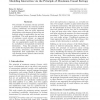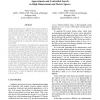28 search results - page 2 / 6 » Distributed control: A sequentially semi-separable approach |
ICML
2010
IEEE
13 years 6 months ago
2010
IEEE
The principle of maximum entropy provides a powerful framework for statistical models of joint, conditional, and marginal distributions. However, there are many important distribu...
CDC
2009
IEEE
13 years 10 months ago
2009
IEEE
— Multi-agent coordination problems can be cast as distributed optimization tasks. Probability Collectives (PCs) are techniques that deal with such problems in discrete and conti...
RTSS
1997
IEEE
13 years 9 months ago
1997
IEEE
In [6], we proposed a new commit protocol, OPT, specially designed for use in distributed firm-deadline real-time database systems. OPT allows transactions to “optimistically�...
IPPS
1999
IEEE
13 years 9 months ago
1999
IEEE
Executing subordinate activities by pushing return addresses on the stack is the most e cient working mode for sequential programs. It is supported by all current processors, yet i...
ICDE
2000
IEEE
14 years 6 months ago
2000
IEEE
In high-dimensional and complex metric spaces, determining the nearest neighbor (NN) of a query object ? can be a very expensive task, because of the poor partitioning operated by...


